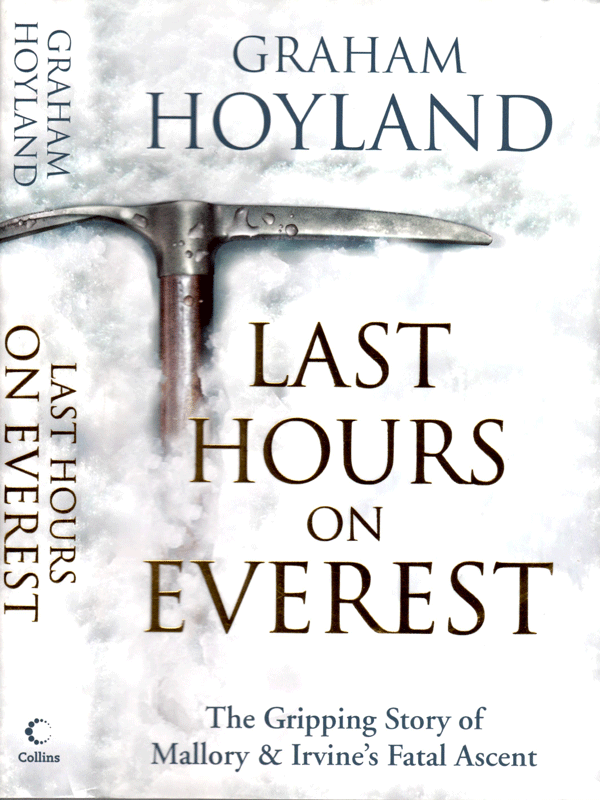Last Hours on Everest: The Gripping Story of Mallory & Irvine’s Fatal Ascent
by Graham Hoyland
London, England: Collins 310 Pages. $26.99 (hardcover)If George Mallory and Andrew Irvine had simply disappeared without a trace on their Everest attempt that June 8th, 1924, they would have left behind an insoluble mystery. Instead, tantalizing clues have appeared: Noel Odell’s glimpse of them their final day in 1924; then Irvine’s axe being found in 1933; and--most dramatic and unexpected--the discovery of Mallory’s body in 1999.
This is the 90th year since the disappearance, and new speculations abound. Maybe the climbers were defeated by the “Second Step,” the one (formidable) obstacle on their route; maybe they surmounted the Step; maybe Odell saw them there; or not; maybe they descended to an alternate route.... That’s just a start. One of the latest to weigh the evidence and speculate is Graham Hoyland. He has certainly paid his dues: Everest “has cost me my marriage, my home and half my possessions." In return for this high price Hoyland has climbed the mountain and responded to the inevitable question: Did they reach the top?
His conclusion is that they did not. He thus joins the ranks of other experienced climbers, many of whom wish that the success they doubt were actual. His chapter “Weighing the Evidence” is comprehensive and judicious. He divides the evidence into “reliable” and less so. The latter includes--rightly, I think--that final day sighting. “Odell changed his story so much,” Hoyland says, that his claims are inconclusive. Although he was a fine observer, Odell was a long away from the climbers. If he really saw a brisk ascent of one of the ridge’s “steps,” it could not plausibly have been the second one. That steep outcrop is now surmounted by a ladder installed in 1975. But for the ladder, it would be an enormous obstacle--all the more for climbers in 1924 gear, without pitons. One conjecture is that the climbers abandoned their attempt on the Step and descended into the Norton Couloir farther along. Unlikely but, like similar theories, not impossible either.
Perhaps Hoyland’s greatest contribution to the debate is his analysis of the weather that June 8th. Odell’s report describes a “squall” on the ridge. Hoyland thinks conditions far worse. In collaboration with two University of Toronto professors, he published an article demonstrating the unusually low barometric pressure that season, which would have exacerbated the difficulties that the two climbers faced.
An obsessive adventurer, Hoyland weaves his own story into Mallory’s. He describes his cousin, T.H. Somervell, twice on Everest with Mallory, who became a missionary doctor in India. You can find a gallery of books on Mallory, but none on Somervell (read his autobiography, After Everest). Only a few days before June 8th, he and Edward Norton climbed above 28,000 feet, a record. Unlike Mallory and Irvine, they used no supplementary oxygen.
We meet Hoyland’s uncle (killed on Mont Blanc in 1934) and “the young woman who would eventually become my ex-wife.” And we learn of his chagrin at being roughly invalided off the expedition that later found Mallory, as well as his quarrels with other theorists about that last climb.
The part of the book that has regrettably received the most popular attention is a claim that Mallory’s body was sighted in the 1930’s by the great Everester Frank Smythe, through a telescope at base camp. (This assertion is also found in Tony Smythe’s very recent biography, My Father, Frank.) This adds little to the story, but begs the question of why he kept the discovery so quiet. Smythe’s answer: “the press would make an unpleasant sensation.”
Hoyland’s claim that he “has finally solved the mystery” of Mallory and Irvine is presumptuous. His analysis is plausible but hardly definitive. Perhaps someday a camera will be found, on Irvine’s body or elsewhere, with film that answers the question. More likely the story will remain like one of those vexing undecidable propositions in mathematics: they reached the top or they didn’t, but we will never be able to prove it either way.

Return to Climbing page.
Return to travel page.
Return to home page.